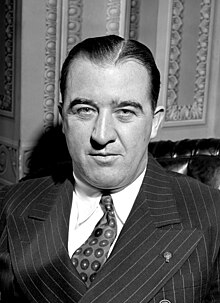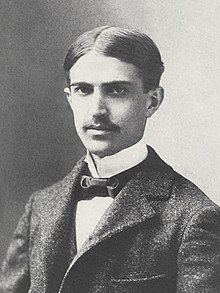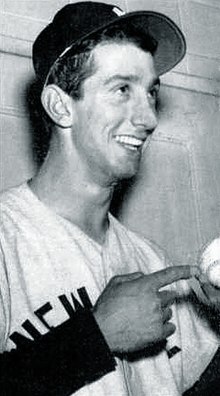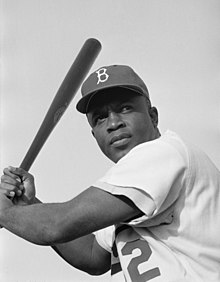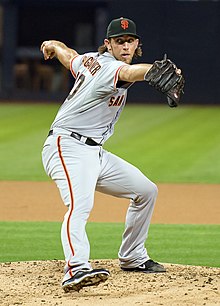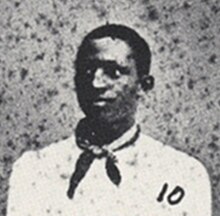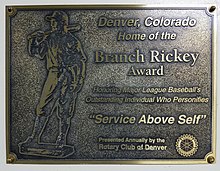Portal:Baseball
Portal maintenance status: (June 2018)
|
| Main page | Content, Categories & Topics | WikiProjects & Things you can do |
The Baseball Portal
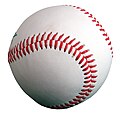
Baseball is a bat-and-ball sport played between two teams of nine players each, taking turns batting and fielding. The game occurs over the course of several plays, with each play generally beginning when a player on the fielding team, called the pitcher, throws a ball that a player on the batting team, called the batter, tries to hit with a bat. The objective of the offensive team (batting team) is to hit the ball into the field of play, away from the other team's players, allowing its players to run the bases, having them advance counter-clockwise around four bases to score what are called "runs". The objective of the defensive team (referred to as the fielding team) is to prevent batters from becoming runners, and to prevent runners' advance around the bases. A run is scored when a runner legally advances around the bases in order and touches home plate (the place where the player started as a batter).
The opposing teams switch back and forth between batting and fielding; the batting team's turn to bat is over once the fielding team records three outs. One turn batting for each team constitutes an inning. A game is usually composed of nine innings, and the team with the greater number of runs at the end of the game wins. Most games end after the ninth inning, but if scores are tied at that point, extra innings are usually played. Baseball has no game clock, though some competitions feature pace-of-play regulations such as the pitch clock to shorten game time.
Baseball evolved from older bat-and-ball games already being played in England by the mid-18th century. This game was brought by immigrants to North America, where the modern version developed. Baseball's American origins, as well as its reputation as a source of escapism during troubled points in American history such as the American Civil War and the Great Depression, have led the sport to receive the moniker of "America's Pastime"; since the late 19th century, it has been unofficially recognized as the national sport of the United States, though in modern times is considered less popular than other sports, such as American football. In addition to North America, baseball spread throughout the rest of the Americas and the Asia–Pacific in the 19th and 20th centuries, and is now considered the most popular sport in parts of Central and South America, the Caribbean, and East Asia, particularly in Japan, South Korea, and Taiwan. (Full article...)
 Featured articles - load new batch
Featured articles - load new batch
-
Image 1Los Angeles Angels center fielder Mike Trout hits a home run on a pitch from New York Mets pitcher Tommy Milone on May 21, 2017.
Baseball is a bat-and-ball sport played between two teams of nine players each, taking turns batting and fielding. The game occurs over the course of several plays, with each play generally beginning when a player on the fielding team, called the pitcher, throws a ball that a player on the batting team, called the batter, tries to hit with a bat. The objective of the offensive team (batting team) is to hit the ball into the field of play, away from the other team's players, allowing its players to run the bases, having them advance counter-clockwise around four bases to score what are called "runs". The objective of the defensive team (referred to as the fielding team) is to prevent batters from becoming runners, and to prevent runners' advance around the bases. A run is scored when a runner legally advances around the bases in order and touches home plate (the place where the player started as a batter).
The initial objective of the batting team is to have a player reach first base safely; this generally occurs either when the batter hits the ball and reaches first base before an opponent retrieves the ball and touches the base, or when the pitcher persists in throwing the ball out of the batter's reach. Players on the batting team who reach first base without being called "out" can attempt to advance to subsequent bases as a runner, either immediately or during teammates' turns batting. The fielding team tries to prevent runs by using the ball to get batters or runners "out", which forces them out of the field of play. The pitcher can get the batter out by throwing three pitches which result in strikes, while fielders can get the batter out by catching a batted ball before it touches the ground, and can get a runner out by tagging them with the ball while the runner is not touching a base. (Full article...) -
Image 2
Charles Dillon "Casey" Stengel (/ˈstɛŋɡəl/; July 30, 1890 – September 29, 1975) was an American Major League Baseball right fielder and manager, best known as the manager of the championship New York Yankees of the 1950s and later, the expansion New York Mets. Nicknamed "the Ol' Perfessor", he was elected to the Baseball Hall of Fame in 1966.
Stengel was born in Kansas City, Missouri, in 1890. In 1910, he began a professional baseball career that would span over half a century. After almost three seasons in the minor leagues, Stengel reached the major leagues late in 1912, as an outfielder, for the Brooklyn Dodgers. His six seasons there saw some success, among them playing for Brooklyn's 1916 National League championship team, but he also developed a reputation as a clown. After repeated clashes over pay with the Dodgers owner, Charlie Ebbets, Stengel was traded to the Pittsburgh Pirates in 1918; however, he enlisted in the Navy that summer, for the remainder of World War I. After returning to baseball, he continued his pay disputes, resulting in trades to the Philadelphia Phillies (in 1919) and to the New York Giants (in 1921). There, he learned much about baseball from the manager, John McGraw, and had some of the glorious moments in his career, such as hitting an inside-the-park home run in Game 1 of the 1923 World Series to defeat the Yankees. His major league playing career ended with the Boston Braves in 1925, but he then began a career as a manager. (Full article...) -
Image 3
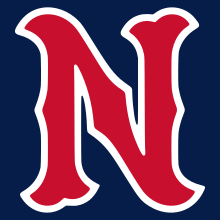
The Nashville Sounds are a Minor League Baseball team of the International League and the Triple-A affiliate of the Milwaukee Brewers. They are located in Nashville, Tennessee, and are named for the city's association with the music industry, specifically the "Nashville sound", a subgenre of country music which originated in the city in the mid-1950s. The team plays their home games at First Horizon Park, which opened in 2015 on the site of the historic Sulphur Dell ballpark. The Sounds previously played at Herschel Greer Stadium from its opening in 1978 until the end of the 2014 season. They are the oldest active professional sports franchise in Nashville.
Established as an expansion team of the Double-A Southern League in 1978, the Sounds led all of Minor League Baseball in attendance in their inaugural season and continued to draw the Southern League's largest crowds in each of their seven years as members. On the field, the team won six consecutive second-half division titles from 1979 to 1984 and won the Southern League championship twice: in 1979 as the Double-A affiliate of the Cincinnati Reds and again in 1982 as the Double-A affiliate of the New York Yankees. (Full article...) -
Image 4
Morris Berg (March 2, 1902 – May 29, 1972) was an American professional baseball catcher and coach in Major League Baseball who later served as a spy for the Office of Strategic Services during World War II. He played 15 seasons in the major leagues, almost entirely for four American League teams, though he was never more than an average player and was better known for being "the brainiest guy in baseball." Casey Stengel once described Berg as "the strangest man ever to play baseball."
Berg was a graduate of Princeton University and Columbia Law School, spoke several languages, and regularly read ten newspapers a day. His reputation as an intellectual was fueled by his successful appearances as a contestant on the radio quiz show Information Please, in which he answered questions about the etymology of words and names from Greek and Latin, historical events in Europe and the Far East, and ongoing international conferences. (Full article...) -
Image 5
Harmon Clayton Killebrew Jr. (/ˈkɪlɪbruː/; June 29, 1936 – May 17, 2011), nicknamed "the Killer" and "Hammerin' Harmon", was an American professional baseball first baseman, third baseman, and left fielder. He spent most of his 22-year career in Major League Baseball (MLB) with the Minnesota Twins. A prolific power hitter, Killebrew had the fifth-most home runs in major league history at the time of his retirement. He was second only to Babe Ruth in American League (AL) home runs, and was the AL career leader in home runs by a right-handed batter. Killebrew was inducted into the National Baseball Hall of Fame in 1984.
Killebrew was 5-foot-11-inch (180 cm) tall and 213 pounds (97 kg). His compact swing generated tremendous power and made him one of the most feared power hitters of the 1960s, when he hit at least 40 home runs per season eight times. In total Killebrew led the league six times in home runs and three times in RBIs, and was named to 13 All-Star teams. In 1965, he played in the World Series with the Twins, who lost to the Los Angeles Dodgers. His finest season was 1969, when he hit 49 home runs, recorded 140 RBIs and won the AL Most Valuable Player Award while helping lead the Twins to the AL West pennant. (Full article...) -
Image 6Adenhart pitching for the Salt Lake Bees in 2008
Nicholas James Adenhart (August 24, 1986 – April 9, 2009) was an American right-handed baseball starting pitcher who played parts of two seasons in Major League Baseball (MLB) for the Los Angeles Angels of Anaheim. In just four career games, Adenhart pitched 18 innings and posted a win-loss record of 1–0.
A graduate of Williamsport High School, Adenhart was highly touted as a high school prospect until an injury in his final game required Tommy John surgery. The Angels drafted him in the 14th round of the 2004 Major League Baseball draft, and began playing in their minor league system after the surgery was a success. He spent three full seasons in the minor leagues before making his major league debut on May 1, 2008. After appearing in three games, Adenhart spent the rest of 2008 in the minor leagues developing his skills, and in 2009 he earned a spot in the Angels' starting rotation. (Full article...) -
Image 7
Albert Benjamin "Happy" Chandler Sr. (July 14, 1898 – June 15, 1991) was an American politician from Kentucky. He represented Kentucky in the U.S. Senate and served as its 44th and 49th governor. Aside from his political positions, he also served as the second commissioner of baseball from 1945 to 1951 and was inducted into the Baseball Hall of Fame in 1982. His grandson, Ben Chandler, later served as congressman for Kentucky's Sixth District.
A multi-sport athlete during his college days at Transylvania College, Chandler briefly considered a career in professional baseball before deciding to pursue a law degree. After graduation, he entered politics and was elected as a Democrat to the Kentucky Senate in 1929. Two years later, he was elected lieutenant governor, serving under Governor Ruby Laffoon. Chandler and Laffoon disagreed on the issue of instituting a state sales tax and when Chandler, the presiding officer in the state senate, worked to block the legislation, Laffoon's allies in the General Assembly stripped him of many of his statutory powers. The tax then passed by a narrow margin. Knowing that Laffoon would try to select his own successor at the Democratic nominating convention, Chandler waited until Laffoon left the state—leaving Chandler as acting governor—and called the legislature into session to enact a mandatory primary election bill. The bill passed, and in the ensuing primary, Chandler defeated Laffoon's choice, Thomas Rhea. He then went on to defeat Republican King Swope by the largest margin of victory for a Kentucky gubernatorial race at that time. As governor, Chandler oversaw the repeal of the sales tax, replacing the lost revenue with new excise taxes and the state's first income tax. He also enacted a major reorganization of state government, realizing significant savings for the state. He used these savings to pay off the state debt and improve the state's education and transportation systems. (Full article...) -
Image 8
Osborne Earl Smith (born December 26, 1954) is an American former professional baseball player. Nicknamed "The Wizard of Oz", Smith played shortstop for the San Diego Padres and St. Louis Cardinals in Major League Baseball, winning the National League Gold Glove Award for defensive play at shortstop for 13 consecutive seasons. A 15-time All-Star, Smith accumulated 2,460 hits and 580 stolen bases during his career, and won the National League Silver Slugger Award as the best hitter at shortstop in 1987. He was elected to the Baseball Hall of Fame in his first year of eligibility in 2002. He was also elected to the St. Louis Cardinals Hall of Fame in the inaugural class of 2014.
Smith was born in Mobile, Alabama; his family moved to Watts, Los Angeles, when he was six years old. While participating in childhood athletic activities, Smith possessed quick reflexes; he went on to play baseball at Locke High School in Los Angeles, then at California Polytechnic State University, San Luis Obispo. Drafted as an amateur player by the Padres, Smith made his major league debut in 1978. He quickly established himself as an outstanding fielder, and later became known for performing backflips on special occasions while taking his position at the beginning of a game. Smith won his first Gold Glove Award in 1980 and made his first All-Star Game appearance in 1981. (Full article...) -
Image 9

Cobb in 1913
During the 1912 baseball season, center fielder Ty Cobb of the Detroit Tigers was suspended for ten days after entering the spectator stands at New York's Hilltop Park during a game and physically assaulting Claude Lucker, a heckler. At the time, Cobb was among the biggest stars in the major leagues. American League president Ban Johnson suspended Cobb and fined him $50 ($1,600 in 2023).
Cobb had been Lucker's verbal target throughout the four-game series between the Tigers and New York Yankees. Facing a continued stream of insults and questioning about his racial ancestry, Cobb lost his temper in the fourth inning of the fourth game, on May 15, 1912. He raced into the stands, punching and kicking Lucker; Lucker had lost eight fingers in an industrial accident and could not defend himself. Cobb was ejected from the game. Johnson witnessed these events and suspended Cobb indefinitely. Since there were few protections for ballplayers at the time from insults and objects hurled by fans, many took Cobb's side, including his teammates. After defeating the Philadelphia Athletics on May 17, the Detroit players telegraphed Johnson that they would not play again until Cobb was reinstated; Johnson refused to do so. (Full article...) -
Image 10The Nashville Sounds Minor League Baseball team was established in Nashville, Tennessee, in 1978, after Larry Schmittou and a group of investors purchased the rights to operate an expansion franchise of the Double-A Southern League. The Sounds played their home games at Herschel Greer Stadium from its opening in 1978 until the end of the 2014 season. In 2015, the Sounds left Greer for First Tennessee Park, now known as First Horizon Park, a new facility located on the site of the historic Sulphur Dell ballpark, home to Nashville's minor league teams from 1885 to 1963.
The Sounds led all of Minor League Baseball in attendance in their inaugural season and continued to draw the Southern League's largest crowds in each of their seven years as members of the league. On the field, the team won six consecutive second-half division titles from 1979 to 1984 and won the Southern League championship twice: in 1979 as the Double-A affiliate of the Cincinnati Reds and again in 1982 as the Double-A affiliate of the New York Yankees. (Full article...) -
Image 11
Stephen Crane (November 1, 1871 – June 5, 1900) was an American poet, novelist, and short story writer. Prolific throughout his short life, he wrote notable works in the Realist tradition as well as early examples of American Naturalism and Impressionism. He is recognized by modern critics as one of the most innovative writers of his generation.
The ninth surviving child of Methodist parents, Crane began writing at the age of four and had several articles published by 16. Having little interest in university studies though he was active in a fraternity, he left Syracuse University in 1891 to work as a reporter and writer. Crane's first novel was the 1893 Bowery tale Maggie: A Girl of the Streets, generally considered by critics to be the first work of American literary Naturalism. He won international acclaim for his Civil War novel The Red Badge of Courage (1895), considered a masterpiece by different critics and writers. (Full article...) -
Image 12Disco Demolition Night was a Major League Baseball (MLB) promotion on Thursday, July 12, 1979, at Comiskey Park in Chicago, Illinois, that ended in a riot. At the climax of the event, a crate filled with disco records was blown up on the field between games of the twi-night doubleheader between the Chicago White Sox and the Detroit Tigers. Many had come to see the explosion rather than the games and rushed onto the field after the detonation. The playing field was so damaged by the explosion and by the rioters that the White Sox were required to forfeit the second game to the Tigers.
In the late 1970s, dance-oriented disco was the most popular music genre in the United States, particularly after being featured in hit films such as Saturday Night Fever (1977). However, disco sparked a major backlash from rock music fans—an opposition prominent enough that the White Sox, seeking to fill seats at Comiskey Park during a lackluster season, engaged Chicago shock jock and anti-disco campaigner Steve Dahl for the promotion at the July 12 doubleheader. Dahl's sponsoring radio station was WLUP (97.9 FM, now WCKL), so admission was discounted to 98 cents for attendees who turned in a disco record; between games, Dahl was to destroy the collected vinyl in an explosion. (Full article...) -
Image 13
Alfred Manuel "Billy" Martin Jr. (May 16, 1928 – December 25, 1989) was an American Major League Baseball second baseman and manager who, in addition to leading other teams, was five times the manager of the New York Yankees. First known as a scrappy infielder who made considerable contributions to the championship Yankee teams of the 1950s, he then built a reputation as a manager who would initially make bad teams good, before ultimately being fired amid dysfunction. In each of his stints with the Yankees he managed them to winning records before being fired by team owner George Steinbrenner or resigning under fire, usually amid a well-publicized scandal such as Martin's involvement in an alcohol-fueled fight.
Martin was born in a working-class section of Berkeley, California. His skill as a baseball player gave him a route out of his home town. Signed by the Pacific Coast League Oakland Oaks, Martin learned much from Casey Stengel, the man who would manage him both in Oakland and in New York, and enjoyed a close relationship with Stengel. Martin's spectacular catch of a wind-blown Jackie Robinson popup late in Game Seven of the 1952 World Series saved that series for the Yankees, and he was the hitting star of the 1953 World Series, earning the Most Valuable Player award in the Yankee victory. He missed most of two seasons, 1954 and 1955, after being drafted into the Army, and his abilities never fully returned; the Yankees traded him after a brawl at the Copacabana club in New York during the 1957 season. Martin bitterly resented being traded, and did not speak to Stengel for years, a time during which Martin completed his playing career with various teams. (Full article...) -
Image 14
Jack Roosevelt Robinson (January 31, 1919 – October 24, 1972) was an American professional baseball player who became the first African-American to play in Major League Baseball (MLB) in the modern era. Robinson broke the color line when he started at first base for the Brooklyn Dodgers on April 15, 1947. The Dodgers signing Robinson heralded the end of racial segregation in professional baseball, which had relegated black players to the Negro leagues since the 1880s.
Born in Cairo, Georgia, Robinson was raised in Pasadena, California. A four-sport student athlete at Pasadena Junior College and the University of California, Los Angeles, he was better known for football than he was for baseball, becoming a star college player with the UCLA Bruins football team. Following his college career, Robinson was drafted for service during World War II but was court-martialed for refusing to sit at the back of a segregated Army bus, eventually being honorably discharged. Afterwards, he signed with the Kansas City Monarchs of the Negro leagues, where he caught the eye of Branch Rickey, general manager of the Brooklyn Dodgers, who thought he would be the perfect candidate for breaking the color line in MLB. (Full article...) -
Image 15

KARE (channel 11) is a television station licensed to Minneapolis, Minnesota, United States, serving as the Twin Cities area's NBC affiliate. Owned by Tegna Inc., the station maintains studios on Olson Memorial Highway (MN 55) in Golden Valley and a transmitter at the Telefarm site in Shoreview, Minnesota.
Channel 11 began broadcasting on September 1, 1953. It was originally shared by WMIN-TV in St. Paul and WTCN-TV in Minneapolis; the two stations shared an affiliation with ABC and alternated presenting local programs. In 1955, Consolidated Television and Radio bought both stations and merged them as WTCN-TV from the Minneapolis studios in the Calhoun Beach Hotel. The station presented several regionally and nationally notable children's shows in its early years as well as local cooking, news, and sports programs. Time Inc. purchased the station in 1957. Under its ownership, ABC switched its affiliation to KMSP-TV (channel 9), leaving channel 11 to become an independent station that broadcast games of the Minnesota Twins baseball team, movies, and syndicated programs. This continued under two successive owners: Chris-Craft Industries and Metromedia. By the late 1970s, WTCN was one of the nation's most financially successful independent stations. (Full article...)
General images - load new batch
-
Image 1Alexander Cartwright, father of modern baseball (from History of baseball)
-
Image 22013 World Baseball Classic championship match between the Dominican Republic and Puerto Rico, March 20, 2013 (from Baseball)
-
Image 3Jackie Robinson in 1945, with the era's Kansas City Royals, a barnstorming squad associated with the Negro American League's Kansas City Monarchs (from Baseball)
-
Image 4A game from the Cantigas de Santa Maria, c. 1280, involving tossing a ball, hitting it with a stick and competing with others to catch it (from History of baseball)
-
Image 6Japanese-Americans spectating a World War II-era game while in an internment camp. America's ties to immigrants and to Japan have been deeply shaped by a shared baseball heritage. (from History of baseball)
-
Image 8Cy Young—the holder of many major league career marks, including wins and innings pitched, as well as losses—in 1908. MLB's annual awards for the best pitcher in each league are named for Young. (from Baseball)
-
Image 9Cover of Official Base Ball Rules, 1921 edition, used by the American League and National League (from Baseball rules)
-
Image 10A well-worn baseball (from Baseball)
-
Image 11A New York Yankees batter (Andruw Jones) and a Boston Red Sox catcher at Fenway Park (from Baseball)
-
Image 13The NL champion New York Giants baseball team, 1913. Fred Merkle, sixth in line, had committed a baserunning gaffe in a crucial 1908 game that became famous as Merkle's Boner. (from History of baseball)
-
Image 15By the 1860s Civil War, baseball (bottom) had overtaken its fellow bat-and-ball sport cricket (top) in popularity within the United States. (from History of baseball)
-
Image 16A first baseman receives a pickoff throw, as the runner dives back to first base. (from Baseball)
-
Image 17Sadaharu Oh managing the Japan national team in the 2006 World Baseball Classic. Playing for the Central League's Yomiuri Giants (1959–80), Oh set the professional world record for home runs. (from Baseball)
-
Image 18Rickey Henderson—the major leagues' all-time leader in runs and stolen bases—stealing third base in a 1988 game (from Baseball)
-
Image 19Baseball games sometimes end in a walk-off home run, with the batting team usually gathering at home plate to celebrate the scoring of the winning run(s). (from Baseball rules)
-
Image 20Baserunners generally stand a short distance away from their base between pitches, preparing themselves to either go back or steal the next base. (from Baseball rules)
-
Image 21The strike zone determines the result of most pitches, and varies in vertical length for each batter. (from Baseball)
-
Image 24The typical motion of a right-handed pitcher (from Baseball rules)
-
Image 25The strike zone, which determines the outcome of most pitches, varies in vertical length depending on the batter's typical height while swinging. (from Baseball rules)
-
Image 26Two players on the baseball team of Tokyo, Japan's Waseda University in 1921 (from Baseball)
-
Image 29A batter follows through after swinging at a pitched ball. (from Baseball rules)
-
Image 30Pesäpallo, a Finnish variation of baseball, was invented by Lauri "Tahko" Pihkala in the 1920s, and after that, it has changed with the times and grown in popularity. Picture of Pesäpallo match in 1958 in Jyväskylä, Finland. (from Baseball)
-
Image 31Sadaharu Oh managing the Japan national team in the 2006 World Baseball Classic. Playing for the Central League's Yomiuri Giants (1959–80), Oh set the professional world record for home runs with 868. (from History of baseball)
-
Image 321906 World Series, infielders playing "in" for the expected bunt and the possible play at the plate with the bases loaded (from Baseball rules)
-
Image 33The American Tobacco Company's line of baseball cards featured shortstop Honus Wagner of the Pittsburgh Pirates from 1909 to 1911. In 2007, the card shown here sold for $2.8 million. (from Baseball)
-
Image 34A runner sliding into home plate and scoring. (from Baseball)
-
Image 35Jackie Robinson in 1945, with the era's Kansas City Royals, a barnstorming squad associated with the Negro American League's Kansas City Monarchs (from History of baseball)
-
Image 36Fenway Park, home of the Boston Red Sox. The Green Monster is visible beyond the playing field on the left. (from Baseball)
-
Image 37The standard fielding positions (from Baseball rules)
-
Image 38Defensive positions on a baseball field, with abbreviations and scorekeeper's position numbers (not uniform numbers) (from Baseball)
-
Image 39Pick-off attempt on runner (in red) at first base (from Baseball rules)
-
Image 40In May 2010, the Philadelphia Phillies' Roy Halladay pitched the 20th major league perfect game. That October, he pitched only the second no-hitter in MLB postseason history. (from History of baseball)
-
Image 41Diagram of a baseball field Diamond may refer to the square area defined by the four bases or to the entire playing field. The dimensions given are for professional and professional-style games. Children often play on smaller fields. (from Baseball)
-
Image 42Pitchers are generally substituted during mound visits (team gatherings at the pitcher's mound). (from Baseball rules)
-
Image 44A pitcher handing off the ball after being taken out of the game during a mound meeting. (from Baseball)
-
Image 45An Afghan girl playing baseball in August 2002 (from Baseball)
 Good articles - load new batch
Good articles - load new batch
-
Image 1Fenway Park in Boston, game venue
The 1948 American League tie-breaker game was a one-game extension to Major League Baseball's (MLB) 1948 regular season, played between the Cleveland Indians and Boston Red Sox to determine the winner of the American League (AL) pennant. The game was played on October 4, 1948, at Fenway Park in Boston, Massachusetts. It was necessary after both teams finished the season with identical win–loss records of 96–58. This was the first-ever one-game playoff in the AL, and the only one before 1969, when the leagues were split into divisions.
The Indians defeated the Red Sox, 8–3, as the Indians scored four runs in the fourth inning and limited the Red Sox to five hits. The Indians advanced to the 1948 World Series, where they defeated the Boston Braves, four games to two, giving them their second and most recent World Series championship. In baseball statistics, the tie-breaker counted as the 155th regular season game by both teams, with all events in the game added to regular season statistics. (Full article...) -
Image 2

Wilmer David "Vinegar Bend" Mizell Sr. (August 13, 1930 – February 21, 1999) was an American athlete and politician. From 1952 to 1962, he was a left-handed pitcher for the St. Louis Cardinals, Pittsburgh Pirates and New York Mets of Major League Baseball. Six years after retiring, he was elected to the United States House of Representatives from North Carolina's 5th congressional district. He served three terms as a Republican from 1969 to 1975.
Mizell was born in Leakesville, Mississippi, but started playing baseball in Vinegar Bend, Alabama, the town from which he drew his nickname. Signed by the Cardinals in 1949, he debuted with them in 1952, ranking among the Top 10 in the National League (NL) in strikeouts for two years before spending 1954 and 1955 in military service. He returned to the Cardinals in 1956 and was named to two Major League Baseball All-Star Games in 1959, but St. Louis felt like he never attained his full potential. They traded him to Pittsburgh early in the 1960 season, and Mizell led the NL in winning percentage (.636) as the Pirates defeated the New York Yankees in the 1960 World Series. He remained with the Pirates until early in the 1962 season, last pitching in the major leagues with the Mets. (Full article...) -
Image 3
John Frederick Maulbetsch (June 20, 1890 – September 14, 1950) was an All-American football halfback at Adrian College in 1911 and for the University of Michigan Wolverines from 1914 to 1916. He is also a member of the College Football Hall of Fame.
After playing with an independent football team in Ann Arbor and at Adrian College, Maulbetsch became one of the most famous American football players in 1914 while playing for the University of Michigan. Maulbetsch became known as the "Human Bullet" because of his unusual low, line-plunging style of play, and was also known as the "Featherweight Fullback" because of his light weight and small size. After his performance against Harvard in 1914, in which some reports indicated he gained more than 300 yards, eastern writers, including Damon Runyon, wrote articles touting Maulbetsch. Maulbetsch was also selected by Walter Camp to his All-American team. (Full article...) -
Image 4
Madison Kyle Bumgarner (born August 1, 1989), nicknamed "MadBum", is an American professional baseball pitcher who is a free agent. Previously, he pitched in Major League Baseball (MLB) for the San Francisco Giants (2009–19) and Arizona Diamondbacks (2020–23). Bumgarner has won three World Series championships (2010, 2012, 2014) and two Silver Slugger Awards (2014, 2015). He has also been selected to four National League (NL) All-Star teams and has the most strikeouts in franchise history by a Giants left-handed pitcher.
Bumgarner played high school baseball at South Caldwell High School in Hudson, North Carolina, where he helped his team win the 2007 4A State Championship. After graduating, he was selected with the tenth overall pick in the 2007 MLB draft by the San Francisco Giants. He and Buster Posey both made their Major League debuts in 2009 and established a reputation as one of the best batteries in recent MLB history. Bumgarner pitched eight scoreless innings in Game 4 of the 2010 World Series, helping win the franchise's first World Series in San Francisco and the first since 1954. Two years later, Bumgarner pitched seven more scoreless innings in Game 2 of the 2012 World Series. In 2014, Bumgarner started the Wild Card game for the Giants, throwing a shutout against the Pittsburgh Pirates. He set the World Series record for the lowest earned run average (ERA) in 2014, with an ERA of 0.43, and took home the Most Valuable Player award as the Giants won their third World Series during his time in San Francisco. (Full article...) -
Image 5
Samuel Timothy Coonrod (born September 22, 1992) is an American professional baseball pitcher who is a free agent. He has previously played in Major League Baseball (MLB) for the San Francisco Giants, Philadelphia Phillies, and New York Mets.
Coonrod was born in St. Louis, Missouri, and raised in Carrollton, Illinois. He played high school baseball at Carrollton High School, where he helped his team win a state championship his senior season and became the first player in school history to have his jersey number retired. After high school, Coonrod spent three years playing college baseball with the Southern Illinois Salukis of the Missouri Valley Conference. He also played for two collegiate summer baseball teams: the Quincy Gems in 2012 and the Yarmouth-Dennis Red Sox in 2013. (Full article...) -
Image 6
Travis Calvin Jackson (November 2, 1903 – July 27, 1987) was an American baseball shortstop. In Major League Baseball (MLB), Jackson played for the New York Giants from 1922 through 1936, winning the 1933 World Series, and representing the Giants in the MLB All-Star Game in 1934. After his retirement as a player, Jackson managed in minor league baseball through to the 1960 season.
Jackson was discovered by Kid Elberfeld at a minor league baseball game at the age of 14. Elberfeld signed Jackson to his first professional contract, and recommended him to John McGraw, manager of the Giants. His exceptional range at shortstop led to the nickname "Stonewall." Jackson was inducted into the National Baseball Hall of Fame in 1982. (Full article...) -
Image 7
Weldy Wilberforce Walker (July 27, 1860 – November 23, 1937), sometimes known as Welday Walker and W. W. Walker, was an American baseball player. In 1884, he became the third African American to play Major League Baseball.
Walker played at Oberlin College and the University of Michigan. In July 1884, he joined the Toledo Blue Stockings of the American Association which was then part of Major League Baseball. His brother Moses Fleetwood Walker, commonly known as Fleetwood (or "Fleet") Walker, was the second African American to play Major League Baseball, making his debut two months before Weldy. In 1887, as racial segregation took hold in professional baseball, Weldy joined the Pittsburgh Keystones of the short-lived National Colored Base Ball League. (Full article...) -
Image 8The 2017 World Series was the championship series of Major League Baseball's (MLB) 2017 season. The 113th edition of the World Series, it was a best-of-seven playoff played between the National League (NL) champion Los Angeles Dodgers and the American League (AL) champion Houston Astros. The series was played between October 24 and November 1.
The Astros defeated the Dodgers, four games to three, to win their first World Series in franchise history, also becoming the first team from Texas to do so. They became the second team in postseason history to win two Game 7s in one postseason, after the 1985 Kansas City Royals. It was the first time since 2001–2002 when two consecutive World Series went to seven games. Both teams set a World Series record with a combined total of 25 home runs throughout the entire series, including a team record 15 home runs by the Astros, and 10 homeruns by the Dodgers, and hit a combined total of eight home runs in Game 2 to set the single game World Series mark. Houston outfielder George Springer was named the World Series Most Valuable Player (MVP) after hitting five home runs in the series to tie a World Series record with Reggie Jackson in 1977 and Chase Utley in 2009. (Full article...) -
Image 9

John James Tigert IV (February 11, 1882 – January 21, 1965) was an American university president, university professor and administrator, college sports coach and the U.S. Commissioner of Education. Tigert was a native of Tennessee and the son and grandson of Methodist bishops. After receiving his bachelor's degree, he earned his master's degree as a Rhodes Scholar.
After completing his education, Tigert taught at Central College; served as the president of Kentucky Wesleyan College; and worked as a professor, sports coach and administrator at the University of Kentucky. (Full article...) -
Image 10Shawn Patrick Sedlacek [sed′–la–check] (born June 29, 1977) is an American former professional baseball pitcher. He played part of one season in Major League Baseball (MLB), primarily as a starting pitcher, for the Kansas City Royals in 2002. Sedlacek threw a four-seam fastball, a two-seam fastball, a changeup, a slider, and a curveball.
Born in Cedar Rapids, Iowa, Sedlacek attended Iowa State University, leading the team with 65 strikeouts and 77 innings pitched as a senior before getting selected by the Royals in the 1998 MLB draft. Initially expected to be a relief pitcher, he became a starting pitcher during his first season due to injuries to other starters, and he would finish among the leaders in the minor leagues he pitched in over the next few years. The Royals called him up in June 2002 following injuries to Jeremy Affeldt and Paul Byrd, and he debuted for them on June 18. Sedlacek posted a 3.05 earned run average (ERA) in his first six starts but had a 10.10 ERA in his next eight and was moved to the bullpen in September. After pitching for Kansas City's minor league affiliates in 2003, he left the Royals organization and played for two years in the minors for several other teams and also in the independent Northern League. Remaining in the Kansas City area following his retirement, he is part of Complete Game Baseball, an organization that provides baseball training and fields its own teams. (Full article...) -
Image 11Knapp with the Toledo Mud Hens in 2023
Andrew Michael Knapp (born November 9, 1991) is an American professional baseball catcher who is a free agent. He has previously played in Major League Baseball (MLB) for the Philadelphia Phillies, Pittsburgh Pirates, Seattle Mariners, Texas Rangers, and San Francisco Giants. He played college baseball for the University of California, Berkeley, and was selected by the Phillies in the second round of the 2013 MLB draft.
A switch hitter, Knapp ascended through the Phillies' minor league system in four seasons, winning the organization's award for best minor league player in 2015. He made his MLB debut in 2017 and served as the team's primary backup catcher for five seasons. (Full article...) -
Image 12
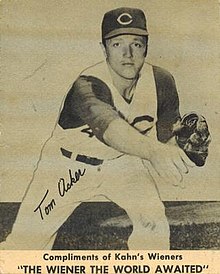
Thomas James Acker (March 7, 1930 – January 4, 2021) was an American baseball pitcher who played his entire career for the Cincinnati Reds in four seasons of Major League Baseball (MLB) from 1956 to 1959. He batted and threw right-handed and served primarily as a relief pitcher.
Acker was signed as an amateur free agent by the New York Giants in 1948 and played for two of their minor league affiliates until 1950, when the Buffalo Bisons drafted him in that year's minor league draft. After spending one season with the organization, he was traded to the Cincinnati Reds in October 1951, the same month he drafted into the US Army. As a result, he missed the 1952 and 1953 seasons. Upon his return from the army, he pitched in the minors until 1956, when the Redlegs promoted him to the major leagues. He played his last game on September 20, 1959, and subsequently worked at the Meadowlands Racetrack from its opening in 1976 until 1992. (Full article...) -
Image 13James Dudley (May 12, 1910 – June 1, 2004) was an American baseball player, professional wrestling manager, and professional wrestling executive. He played Negro league baseball for nine years but is best known for his time with the World Wide Wrestling Federation. Dudley was the first African-American to run a major United States arena (Turner's Arena in Washington, D.C.). He worked with four generations of wrestling's McMahon family and was particularly close with Vincent J. McMahon. At age 74, he was put back on the company's payroll to show appreciation for his work for the McMahons. He also managed several wrestlers in the WWWF and was inducted into the WWF Hall of Fame class of 1994. (Full article...)
-
Image 14
On June 12, 1880, Lee Richmond of the Worcester Worcesters threw a perfect game against the Cleveland Blues at Worcester County Agricultural Fairgrounds. It was the first perfect game in Major League Baseball history, which at the time only consisted of the National League.
Richmond joined the Worcesters in 1879, and quickly brought legitimacy to the team with his pitching abilities. The day before his perfect game, Richmond attended graduation festivities at Brown University. After celebrating through the night, he participated in a class baseball game in the morning and only slept for a few hours before pitching his perfect game. Of the 27 batters he faced, the at bat that posed the greatest threat to breaking up the perfect game came in the fifth inning. Blues batter Bill Phillips hit what looked to be a single, but Worcesters right fielder Lon Knight fielded the ball and threw to first baseman Chub Sullivan to record the out. (Full article...) -
Image 15

The Yankees–Red Sox rivalry is a Major League Baseball (MLB) rivalry between the New York Yankees and the Boston Red Sox. Both teams have competed in MLB's American League (AL) for over 120 seasons and have since developed what is arguably the fiercest rivalry in all of American sports. In 1919, Red Sox owner Harry Frazee sold star player Babe Ruth to the Yankees, which was followed by an 86-year period in which the Red Sox did not win a World Series. This led to the popularization of a superstition known as the "Curse of the Bambino," which was one of the most well-known aspects of the rivalry.
The rivalry is often a heated subject of conversation, especially in the home region of both teams, the Northeastern United States.
Until the 2014 season, every season's postseason had featured one or both of the AL East rivals since the inception of the wild card format and the resultant additional Division Series in 1995; they have faced each other in the AL Championship Series (ALCS) three times. The Yankees won twice, in 1999 and 2003; while the Red Sox won in 2004. The two teams have also met once in the AL Division Series (ALDS), in 2018, with Boston winning 3–1, a series which included a 16–1 Red Sox win in Game 3 at Yankee Stadium, the most lopsided postseason loss for the Yankees in their history. The Red Sox also beat the Yankees in the 2021 American League Wild Card Game. (Full article...)
Did you know (auto-generated) - load new batch

- ... that before his Major League Baseball career, Leo Posada represented Cuba internationally in cycling?
- ... that while waiting for an interview, journalist Rod Beaton was involved in a shoving incident with baseball player Barry Bonds?
- ... that getting bitten by an eel led Sean Barber to become an umpire?
- ... that Kelsie Whitmore was part of the first all-female battery in a professional baseball league since the All-American Girls Professional Baseball League?
- ... that Amanda Asay was the longest-serving member of the Canadian women's baseball team when she died at 33, having played on the team for sixteen years?
- ... that Salty Parker, who spent 60 years in organized baseball, described his lifelong love of the game as "a beautiful disease"?
- ... that Puerto Rico's Willie Hernández became the highest paid player in Detroit Tigers history after winning Cy Young and Most Valuable Player awards and a World Series?
- ... that baseball player Joey Marciano is a cousin of world heavyweight champion Rocky Marciano?
Quotes
| I bleed Dodger blue and when I die, I'm going to the big Dodger in the sky. |
 Featured lists - load new batch
Featured lists - load new batch
-
Image 1

The 1980 Sounds set a team-best 97–46 (.678) record playing as the Double-A affiliate of the New York Yankees in the Southern League.
The Nashville Sounds Minor League Baseball team has played in Nashville, Tennessee, for 47 years since being established in 1978. As of the completion of the 2024 season, the club has played 6,566 regular-season games and compiled a win–loss record of 3,398–3,168–2 (.518). They have appeared in the postseason on 16 occasions in which they have a record of 49–44 (.527) in 93 games. Combining all 6,659 regular-season and postseason games, Nashville has an all-time record of 3,447–3,212–2 (.518).
Created as an expansion team of the Double-A Southern League (SL) in 1978, the Sounds played in this league through 1984. At the Double-A classification, Nashville was affiliated with Major League Baseball's Cincinnati Reds (1978–1979) and New York Yankees (1980–1984). The Sounds moved up to Triple-A in 1985 as members of the American Association (AA) before joining the Pacific Coast League (PCL) in 1998. They were placed in the Triple-A East (AAAE) in 2021, but this became the International League (IL) in 2022. At this level, they have been affiliates of the Detroit Tigers (1985–1986), Cincinnati Reds (1987–1992), Chicago White Sox (1993–1997), Pittsburgh Pirates (1998–2004), Milwaukee Brewers (2005–2014), Oakland Athletics (2015–2018), and Texas Rangers (2019–2020). The Sounds reaffiliated with the Milwaukee Brewers in 2021. (Full article...) -
Image 2

In baseball, a strikeout occurs when a pitcher throws three strikes to a batter during his time at bat. Under Rules 6.05 and 6.09 of the Official Rules of Major League Baseball, a batter becomes a runner when a third strike is not caught by the catcher with no runner on first base or when there are two outs. The strikeout is recorded, but the batter-runner must be tagged or forced out in order for the defensive team to register the out. Thus, it is possible for a pitcher to record more than three strikeouts in an inning.
As a result of this rule, 93 different pitchers have struck out four batters in a half-inning of a Major League Baseball (MLB) game, the most recent being Tyler Glasnow of the Tampa Bay Rays on July 7, 2023. Five players – Chuck Finley, A. J. Burnett, Zack Greinke, Craig Kimbrel, and Tyler Glasnow – have accomplished the feat more than once in their career (Finley is the only one to do it three times, and all three times were within a one-year span); no player has ever struck out more than four batters in an inning. Ed Crane was the first player to strike out four batters in one inning, doing so in the fifth inning for the New York Giants against the Chicago White Stockings on October 4, 1888. (Full article...) -
Image 3
The All-Star Final Vote was an annual Internet and text message ballot by Major League Baseball (MLB) fans to elect the final player for each team that participates in the Major League Baseball All-Star Game, after all other selections were made and announced. The first 33 players were selected by a combination of procedures. The sponsorship changed annually, but the contest remained similar from year to year. Each league presented a five-man ballot and gave the fans a few days to choose one final All-Star. This process was used from 2002 through 2018. (Full article...) -
Image 4

Barry Bonds has won 12 Silver Slugger Awards, the most of any player at any position.
The Silver Slugger Award is awarded annually to the best offensive player at each position in both the American League (AL) and the National League (NL), as determined by the coaches and managers of Major League Baseball (MLB). These voters consider several offensive categories in selecting the winners, including batting average, slugging percentage, and on-base percentage, in addition to "coaches' and managers' general impressions of a player's overall offensive value". Managers and coaches are not permitted to vote for players on their own team. The Silver Slugger was first awarded in 1980 and is given by Hillerich & Bradsby, the manufacturer of Louisville Slugger bats. The award is a bat-shaped trophy, 3 feet (91 cm) tall, engraved with the names of each of the winners from the league and plated with sterling silver.
As with the Rawlings Gold Glove Award, the prize is presented to outfielders irrespective of their specific position. This means that it is possible for three left fielders, or any other combination of outfielders, to win the award in the same year, rather than one left fielder, one center fielder, and one right fielder. It is also possible for outfield teammates to win the award in the same season, which has happened eight times since 1980. (Full article...) -
Image 5

Justin Upton, the first overall selection in 2005, was named to the 2009 All-Star Team.
The Arizona Diamondbacks are a Major League Baseball franchise based in Phoenix, Arizona. The Diamondbacks compete in the National League West division. Officially known as the "First-Year Player Draft", the Rule 4 Draft is Major League Baseball's primary mechanism for assigning amateur baseball players from high schools, colleges, and other amateur baseball clubs to its teams. The draft order is determined based on the previous season's standings, with the team possessing the worst record receiving the first pick. In addition, teams which lost free agents in the previous off-season may be awarded compensatory or supplementary picks. Since the franchise first participated in the draft in 1996, the Diamondbacks have selected 28 players in the first round. The First-Year Player Draft is unrelated to the 1997 expansion draft in which the Diamondbacks filled their roster.
Of the 28 players picked in the first round by the Diamondbacks, 15 have been pitchers, the most of any position; 11 of these have been right-handed, while 4 have been left-handed. Five players taken in the first round have been shortstops; additionally, two players have been selected at each of first base, third base, catcher, and the outfield. No second baseman has been selected in the first round by the Diamondbacks. The Diamondbacks have drafted 16 players out of college, and 10 out of high school. Arizona has drafted seven players out of high schools or colleges in the state of California, with two being taken from each of Florida, Georgia, and their home state of Arizona. (Full article...) -
Image 6The Most Valuable Player Award given to Hank Aaron in 1957
The Major League Baseball Most Valuable Player Award (MVP) is an annual Major League Baseball (MLB) award given to one outstanding player in the American League and one in the National League. The award has been presented by the Baseball Writers' Association of America (BBWAA) since 1931. (Full article...) -
Image 7
The Branch Rickey Award was given annually to an individual in Major League Baseball (MLB) in recognition of his exceptional community service from 1992 to 2014. The award was named in honor of former player and executive Branch Rickey, who broke the major league color barrier by signing Jackie Robinson, while president and general manager of the Brooklyn Dodgers. Rickey also created the Knothole Gang, a charity that allowed children to attend MLB games.
The award, created by the Rotary Club of Denver in 1991, was first awarded to Dave Winfield in 1992 at their annual banquet. Each MLB team nominates one individual who best exemplifies the Rotary Club motto: "Service Above Self". A vote is then conducted by the national selection committee, which consists of members of the sports media, previous winners of the award, and Rotary district governors in major league cities. Proceeds of the banquet benefit Denver Kids, Inc., a charity for at-risk students who attend Denver Public Schools. Each winner receives a bronze sculpture of a baseball player measuring 24 inches (610 mm), named "The Player", designed by sculptor George Lundeen. A larger version of "The Player", standing 13 feet (4.0 m) tall, was erected at Coors Field in Denver. (Full article...) -
Image 8

The former location of the Phillies Wall of Fame in Ashburn Alley at Citizens Bank Park
The Philadelphia Phillies Wall of Fame, officially known as the Toyota Phillies Wall of Fame for sponsorship reasons, is an exhibit located at Citizens Bank Park in Philadelphia, Pennsylvania. The exhibit is a collection of plaques that honor players and personnel who made significant contributions to the Philadelphia Phillies organization. Each person inducted into the Wall of Fame is honored with a metal plaque showing the person's face, their position with and years of service to the team, along with a summary of the person's notable accolades and contributions during their career. As of 2023, the Phillies have inducted 47 people (49 including the 1983 Centennial Team) into the Wall of Fame. (Full article...) -
Image 9
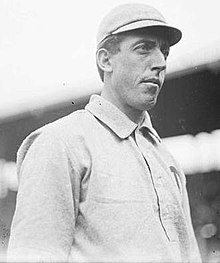
Eddie Plank, the holder of 10 franchise records for the Athletics
The Athletics are a Major League Baseball (MLB) franchise based in Sacramento, California. The Athletics formed in 1901 as the Philadelphia Athletics; after moving to Kansas City for 13 seasons, the Athletics relocated to Oakland, California in 1968. After the 2024 season, the Athletics temporarily moved to West Sacramento, California as part of the franchise's relocation to Las Vegas. Through 2023, the Athletics have played 19,113 games, winning 9,260, losing 9,766, and tying 87, for a winning percentage of approximately .487. This list documents the superlative records and accomplishments of team members during their tenures as Athletics.
Eddie Plank holds the most franchise records as of the end of the 2023 season, with ten, including the most career wins, losses and hit batsmen. He is followed by Jimmie Foxx, who holds nine records, including the best career on-base percentage and the single-season home runs record, as well as Al Simmons, who holds the single season hit and RBI records. (Full article...) -
Image 10The Roberto Clemente Award is given annually to the Major League Baseball (MLB) player who "best exemplifies the game of baseball, sportsmanship, community involvement and the individual's contribution to his team", as voted on by baseball fans and members of the media. It is named for Hall of Fame outfielder Roberto Clemente. Originally known as the Commissioner's Award, it has been presented by MLB since 1971. In 1973, the award was renamed after Clemente following his death in a plane crash while he was delivering supplies to victims of the Nicaragua earthquake.
Each year, a panel of baseball dignitaries selects one player from among 30 nominees, one from each club. Teams choose their nominee during the regular season, and the winner is announced before Game 3 of the World Series. The player who receives the most votes online via MLB's official website, MLB.com, gets one vote in addition to the votes cast by the panel. Since 2007, the Roberto Clemente Award has been presented by Chevy. Chevy donates money and a Chevy vehicle to the recipient's charity of choice and additional money is donated by Chevy to the Roberto Clemente Sports City, a non-profit organization in Carolina, Puerto Rico, that provides national sports activities for children. Chevy donates additional funds to the charity of choice of each of the 30 club nominees. (Full article...) -
Image 11The 1971 Cy Young Award won by Ferguson Jenkins, on display in the Canadian Baseball Hall of Fame
The Cy Young Award is given annually to the best pitchers in Major League Baseball (MLB), one each for the American League (AL) and National League (NL). The award was introduced in 1956 by Baseball Commissioner Ford C. Frick in honor of Hall of Fame pitcher Cy Young, who died in 1955. The award was originally given to the single best pitcher in the major leagues, but in 1967, after the retirement of Frick, the award was given to one pitcher in each league.
Each league's award is voted on by members of the Baseball Writers' Association of America (BBWAA). Local BBWAA chapter chairmen in each MLB city recommend two writers to vote for each award. Final approval comes from the BBWAA national secretrary-treasurer. Writers vote for either the American League or National League awards, depending on the league in which their local team plays. A total of 30 writers vote for each league's awards. Writers cast their votes prior to the start of postseason play. (Full article...) -
Image 12

The Yankees have played home games in the current Yankee Stadium since 2009.
The New York Yankees are a professional baseball team based in the Bronx, a borough of New York City. Also known as "the Bronx Bombers" and "the Pinstripers", the Yankees play in the East Division of Major League Baseball's (MLB) American League (AL). In its 121 MLB seasons, the franchise has won 27 World Series championships, the most of any MLB team and 16 more than the second-place St. Louis Cardinals. The Yankees played home games in Yankee Stadium from 1923 to 2008, except for a stint at Shea Stadium from 1974 to 1975 while Yankee Stadium was undergoing renovations. In 2009, the team moved into a new ballpark, which is also called Yankee Stadium.
The Baltimore Orioles began play in the AL in 1901. After two seasons, the Orioles were replaced by a club in New York; it is unclear whether it was an expansion team or a relocated version of the Orioles. Frank Farrell and William S. Devery purchased the franchise, naming it the New York Highlanders. In 1913, the team changed its name to the Yankees. From 1921 to 1964, the Yankees were the most successful MLB franchise, winning 20 World Series titles and 29 AL pennants. This period included streaks of four consecutive championships from 1936 to 1939 and five straight titles from 1949 to 1953. (Full article...) -
Image 13

Zack Greinke, drafted in 2002, is the only Royals' first-round pick to win a Cy Young Award with the team.
The Kansas City Royals are a Major League Baseball franchise based in Kansas City, Missouri. The franchise, founded in 1969, plays in the American League Central division. Since the institution of Major League Baseball's Rule 4 Draft, the Royals have selected 57 players in the first round. Officially known as the "First-Year Player Draft", the Rule 4 Draft is Major League Baseball's primary mechanism for assigning amateur players from high schools, colleges, and other amateur baseball clubs to its franchises. The draft order is determined based on the previous season's standings with the team that had the worst record receiving the first pick. In addition, teams that lost free agents in the previous off-season may be awarded compensatory or supplementary picks. The First-Year Player Draft is unrelated to the 1968 expansion draft in which the Royals initially filled their roster.
Of the 57 players first-round draft picks, 31 have been pitchers, the most of any position; 20 of these were right-handed, while 11 were left-handed. Twelve outfielders were selected, and eight shortstops, three catchers, and two third basemen were taken. The team also selected one player at first base, but has never drafted a second baseman. Fifteen of the players came from institutions in the state of California, while Florida and Texas follow with seven players each. The Royals have drafted two players, Luke Hochevar (2006) and Aaron Crow (2009), who were playing in the American Association of Independent Professional Baseball draft. Both had been drafted previously by other major league teams but had chosen to play for the Fort Worth Cats instead. They have also drafted one player from Puerto Rico: Juan Lebron (1995). (Full article...) -
Image 14Mariano Rivera won the AL Relief Man Award in 1999, 2001, 2004, 2005, and 2009.
The Rolaids Relief Man Award was an annual Major League Baseball (MLB) award given from 1976 to 2012 to the top relief pitchers of the regular season, one in the American League (AL) and one in the National League (NL).
Relief pitchers enter the game after the starting pitcher is removed. The award was sponsored by the antacid brand Rolaids, whose slogan was "R-O-L-A-I-D-S spells relief." Because the first closers were nicknamed "firemen", a reference to "putting out the fire" of another team's rally, the trophy was a gold-plated firefighter's helmet. (Full article...) -
Image 15

Roy Halladay is the only pitcher in Phillies history to throw multiple no-hit games with the team: a perfect game in May 2010; and a postseason no-hitter in October of that year.
The Philadelphia Phillies are a Major League Baseball franchise based in Philadelphia. They play in the National League East division. Also known in their early years as the "Philadelphia Quakers", pitchers for the Phillies have thrown fourteen separate no-hitters in franchise history. A no-hitter is officially recognized by Major League Baseball only "when a pitcher (or pitchers) allows no hits during the entire course of a game, which consists of at least nine innings", though one or more batters "may reach base via a walk, an error, a hit by pitch, a passed ball or wild pitch on strike three, or catcher's interference". No-hitters of less than nine complete innings were previously recognized by the league as official; however, several rule alterations in 1991 changed the rule to its current form.
Of the fourteen no-hitters pitched by Phillies players, three have been won by a score of 6–0, and three by a score of 1–0, more common than any other results. The largest margin of victory in a Phillies no-hitter was ten runs, in a 10–0 win by Chick Fraser. Charlie Ferguson's no-hitter, the first in franchise history, was a 1–0 victory, as were two of the more recent regular season no-hitters, thrown by Kevin Millwood in 2003 and Roy Halladay in 2010. Three pitchers to throw no-hitters for the Phillies have been left-handed: Johnny Lush (in 1906), Terry Mulholland (in 1990) and Cole Hamels (in 2015). The other nine pitchers were right-handed. Halladay is the only Phillies' pitcher to throw more than one no-hitter in a Phillies uniform, and others, including Hall of Famer Jim Bunning, have pitched more than one in their careers. The longest interval between Phillies no-hitters was between the games pitched by Lush and Bunning, encompassing 58 years, 1 month, and 20 days from May 1, 1906 to June 21, 1964. Conversely, the shortest interval between no-hitters was between Halladay's two 2010 no-hitters, with a total of merely four months and seven days from May 29 to October 6; the shortest gap between regular-season no-hitters was between Mulholland's and Tommy Greene's games (nine months and eight days from August 15, 1990 to May 23, 1991). Two opponents have been no-hit by the Phillies more than one time: the San Francisco Giants, who were defeated by Mulholland (in 1990) and Millwood (in 2003); and the Cincinnati Reds, who were no-hit by Rick Wise (in 1971) and Halladay (in 2010). (Full article...)
More did you know
- ... that despite its author keeping detailed journals of his experiences, the baseball memoir Odd Man Out was criticized by many people named in the book as being factually inaccurate?
- ... that the longest extra inning game in professional baseball history was an International League game that lasted 33 innings?
- ... that two members of the $100,000 infield have been inducted into the Baseball Hall of Fame?
- ... that three of the four batters faced by Mike Palagyi in his one Major League game were later inducted into the Baseball Hall of Fame?
- ... that Boston Red Sox third baseman Will Middlebrooks is engaged to a former Dallas Cowboys cheerleader whom he has known since childhood?
Sports portals
Selected picture

| Credit: National Photo Company |
Tyrus Raymond "Ty" Cobb (December 18, 1886 – July 17, 1961), nicknamed "The Georgia Peach," was a baseball player and is regarded by some historians and journalists as the best player of the dead-ball era and is generally seen as one of the greatest players of all time. Cobb also received the most votes of any player on the 1936 inaugural Hall of Fame Ballot, receiving 222 out of a possible 226 votes. Cobb is widely credited with setting ninety Major League Baseball records during his career.
Associated Wikimedia
The following Wikimedia Foundation sister projects provide more on this subject:
-
Commons
Free media repository -
Wikibooks
Free textbooks and manuals -
Wikidata
Free knowledge base -
Wikinews
Free-content news -
Wikiquote
Collection of quotations -
Wikisource
Free-content library -
Wikiversity
Free learning tools -
Wiktionary
Dictionary and thesaurus
More portals
- Portals with triaged subpages from June 2018
- All portals with triaged subpages
- Portals with no named maintainer
- Automated article-slideshow portals with 51–100 articles in article list
- Automated article-slideshow portals with 501–1000 articles in article list
- Random portal component with 41–50 available subpages
- Automated article-slideshow portals with 201–500 articles in article list
- Random portal component with 11–15 available subpages
- Random portal component with 21–25 available image subpages








